The Sokshing, a Sacred “Spine!”
In the center of the stupa, amidst the sacred substances, relics, and other mantra rolls, there is a fundamental element: the sokshing. The Tibetan term “sokshing,” which is translated as “tree of life” designates an elaborated sculpted tree trunk executed according to specific codes and with corresponding rituals. Generally, it is placed vertically in the center of statues and stupas, acting as a spine. Like every element in Tibetan Buddhism, it has a sacred value and is thus symbolic: it is the link with the ten types of knowledge. (1).
For the sokshing of the stupa that will house Shamar Rinpoche’s relics, we chose a cypress tree from the garden of the Lama House. Before cutting down the tree last autumn (on a date which was anything but random of course), we carried out a practice to ask permission of the various inhabitants of the place (particularly those that live underground)—an indispensable mark of respect. Then, we removed the branched and bark from the trunk before leaving it to dry out for several months.

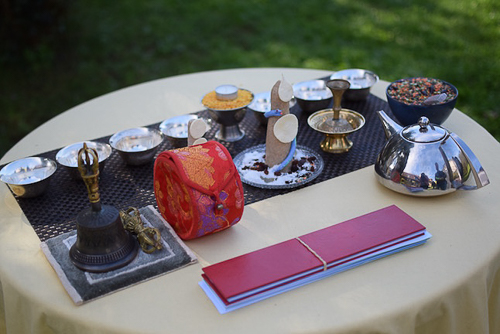
The ceremony preceding the felling of the tree in the Lama House garden with a specific torma offering.
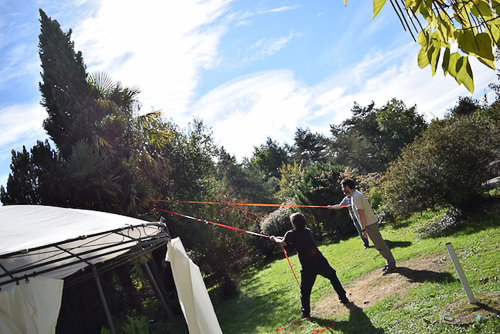

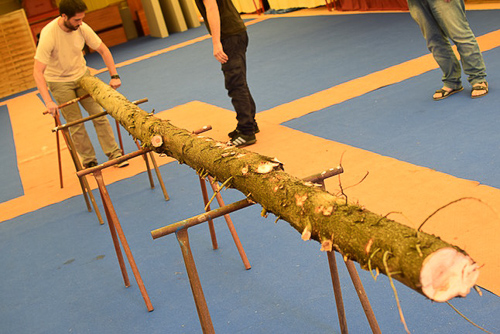
↑ Cutting and branch-removal of the tree
Alain, the sculptor charged with the transformation of the tree trunk, arrives on the scene. He carved it into the traditional form for a three-meter (10-foot) high sokshing, a kind of rectangular pillar with gently pyramidal ends—a bit like an obelisk. He fashioned each end according to tradition: a small stupa for the upper part and a half-dorje for the lower part.
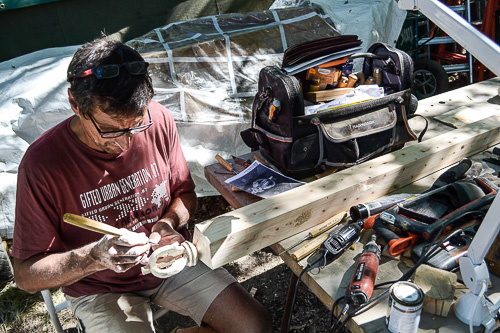
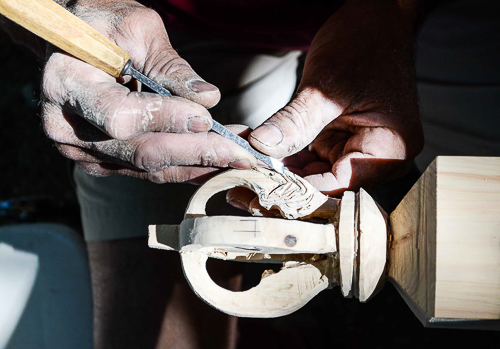
↑ Alain in the midst of sculpting

The stupa, at the head

The half-dorje, at the base
On each side of the sokshing, small niches were carved out to receive offerings: sacred pills and mantras connected to the body (at the upper level of the “tree of life”), connected to the speech (at the central level), and connected to the mind (at the lower level) of the Buddhas. The remaining spaces were filled with saffron and incense powder before these chambers were definitively sealed with covers.
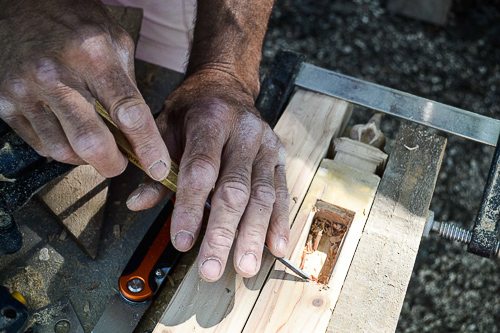
Carving out the niches
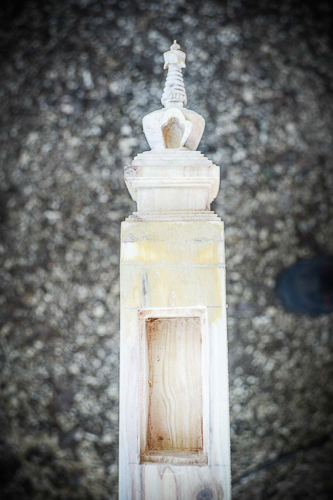


The covers for the niches
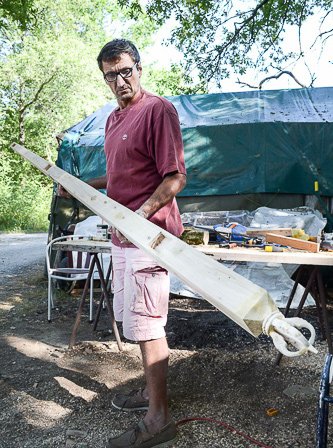
Ready to move on to the next step
As for the small stupa that crowns the sokshing, it welcomed a very special relic offered by Lama Jigme Rinpoche. When Lama Jigme Rinpoche was still a child, the 16th Karmapa offered several of his disciples very important relics. At this time, Lama Jigme Rinpoche received two relics of Buddha Kashyapa into his care, which he guarded preciously up to the present day; one of them can be found in the Buddha statue within the Institute and the second will soon be within Shamar Rinpoche’s stupa (2).
The sokshing was then finished with saffron, the column painted red, the stupa painted white, and the half-dorje painted with the five colors representing the five wisdoms. According to tradition, the length of the sokshing is covered in seed syllables (of the body, speech, mind, qualities, and activities of the Buddhas) as well as mantras. These are written in golden ink and with gold powder, while a halo of the five colors encircles each seed syllable. On the “tree of life” we find the five dharanis (on the upper part) (3), the Sojong prayers of the five Buddhas (in the center) (4) and the auspicious prayers called tashi in Tibetan.
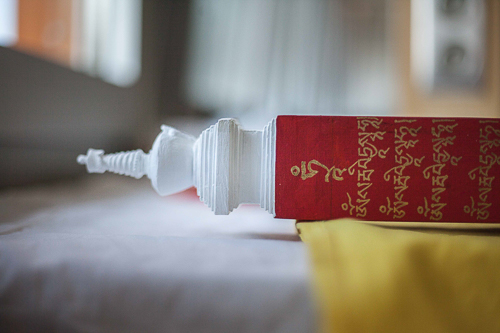
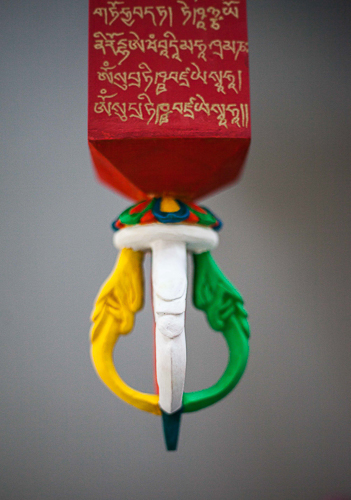
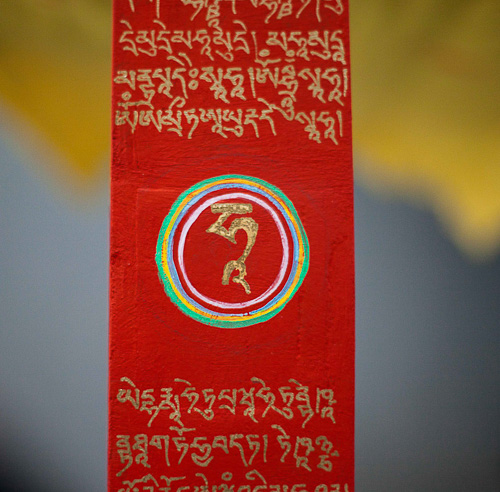
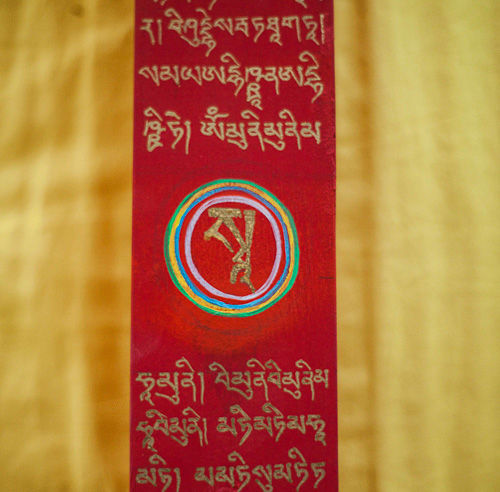
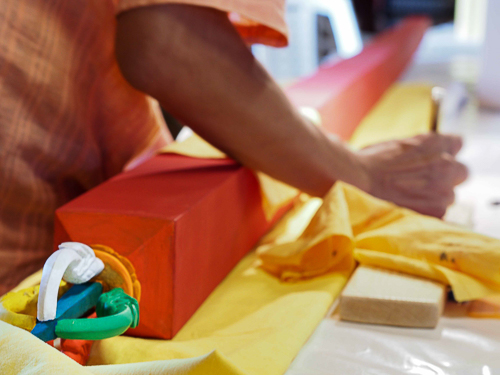
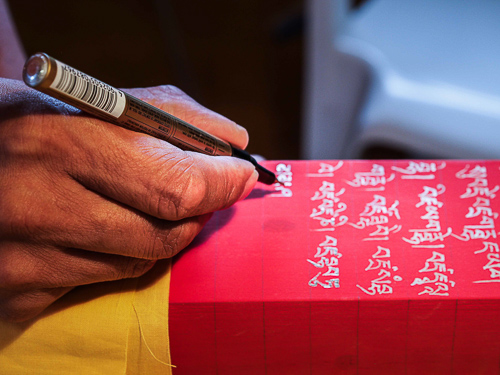
↑ Lama Jampa inscribes the sacred texts in gold ink
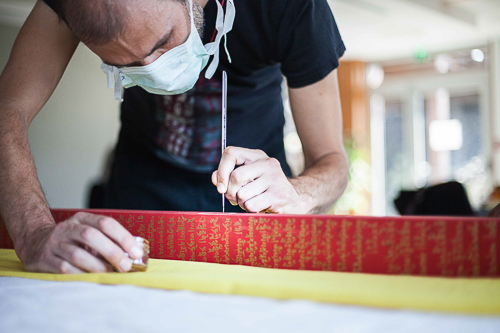


↑ Lama Jampa and Sylvestre at work applying the gold powder
In conclusion, the sokshing is enrobed in saffron-colored fabric and, in the same manner as the mantra rolls, wrapped in five-colored ribbons. It is now completed and awaits its big moment in the stacks of Dhagpo’s library. During the stupa’s construction, the central space will be kept open to welcome it; this “sacred spine” will be the final element placed within the reliquary monument. Just like in July 2015, when the sokshing of the Institute’s Buddha was installed following all the other substances, and by Gyalwa Karmapa himself no less!
Notes – ↑ Top of article
(1) The ten types of knowledge are those of phenomena, mind, connections, illusions, unhappiness, its origin, its cessation, the path that leads there, exhaustion and non-appearance.
(2) Kashyapa is the Buddha who preceded Shakyamuni, our historical Buddha.
(3) A reminder: a dharani is a long mantra that summarizes a teaching of the Buddha; the five great dharanis come directly from Buddha Shakyamuni.
(4) “Sojong Prayers”: These are vows connected to the commitments for individual liberation that one takes for a period of twenty-four hours, from dawn until the dawn of the following day. Both lay and monastic practitioner can observe these vows. There are eight precepts to respect: not killing, not stealing, not lying, not having sexual rapports, not consuming intoxicants, not eating after the midday meal, not sitting on elevated seats, and not adorning oneself (with jewelry, makeup, perfume, etc.).



